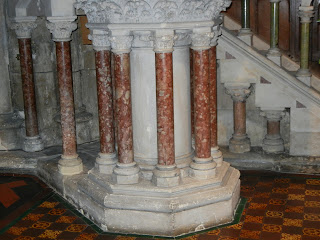On August 2, 2011, we flew to Dublin, Ireland for our first taste of international travel (excluding the Caribbean). This was a 7 day stay in Dublin with a one day trip to County Clare to visit the Cliffs of Moher, a castle and the Irish countryside. Our first impression of the Dublin airport was that it looked very modern and contemporary.
This was home for our 7 days in Dublin. The hotel was in a great location in the city. We were just blocks away from St. Stephens Green park and the Grafton shopping district. I came to appreciate the location later as we walked the city because my initial experience upon arriving to the hotel was discovering how tired I was and truly understanding the term "jet lag". We stayed up as long as we could in an attempt to acclimate to the Ireland time zone difference. In the end, sleep won out and we ordered room service for dinner and called it a day. City exploration commenced the next day after a good night's rest.
 |
| A typical Dublin street |
A lot of the doorways in Dublin have this Georgian archway design. When the Irish were under British rule, a royal decree ordered the people of Dublin to paint all front doors black as a sign of mourning for the Queen's death. So what did the Irish do? They painted their doors any color but black. Therefore, there's a plethora of colorful front doors in the city of Dublin. This red door being a typical example.
European version of the $1 store. Although with the dollar conversion rate, this would be more like a $3 store which is about right because there is some sticker shock when you compare U.S. and European prices.
We thought the ivy vines growing up this building were pretty cool.
This building also displays the ornate iron railings and balconies common on a lot of residences and businesses.
Historic Shelbourne Hotel across the street from St. Stephens Green park. The Ireland Constitution was signed in a room here. JFK and other American dignitaries have also stayed here during visits to Ireland.

 |
| Dublin street |
 |
| Even the street lamps were ornate iron works of art in some parts of the city. |
The Church of St. Augustine and St. John, commonly known as John's Lane Church, is a large Roman Catholic Church located on Thomas Street, Dublin, Ireland. It was opened in 1874 on the site of the medieval St. John's Hospital, founded c. 1180. It is served by the Augustinian Order.[2] The church is named after St. Augustine and St. John the Baptist, but is popularly known as John's Lane Church, from its location at the corner of John's Lane.[5] The church steeple is the highest steeple in the city,[6] standing at over 200 feet (61.0 m). It was originally not designed to hold bells, but a spiral staircase was added later to provide access to bells. The Bell Ringers Company of John's Lane was formed in 1872 and the bells were first rung on St. Patrick's Day 1873.[2][7] 

Abbey Presbyterian Church is a church located at Parnell Square, Dublin. Designed by architect Andrew Heiton of Perth, Scotland, it is a decorated Gothic building, with a spire 180 feet (54.9 m) high. The church was erected in 1864 with funding from Alexander Findlater, a Dublin merchant, and is known colloquially as "Findlater's church".[1][2]
We enjoyed the food in Ireland. Aside from the fish (battered) and chips (fries) a lot of dishes included stews of meat and potatoes. These are just a small sample from one or two meals eaten during our stay. We both were hooked on the brown bread. It was awesome. The fish and chips were good as expected and a lamb stew over a baked potato in a small village in rural Clare County was the best stew that I've ever tasted.
 |
| Vegetable soup with brown bread. |
 |
| Traditional Irish stew. |
 |
| Vegetable soup with brown bread. Crystal preferred this creamy version to the other picture of the vegetable soup. The brown bread was good everywhere. |
 |
| This is something you won't find in the states. It's called mushy peas. Think mashed peas. It was actually pretty good. I kept seeing it on a lot of menus so I thought I'd try it. I also had some with my fish and chips one day. |
 |
| This is a battered mushroom appetizer. |
 |
| Irish Guinness beef stew. This was also a lot better than the traditional stew that I tried at the other restaurant. It was richer and more flavorful and plenty of meat. |
A bronze statue of the infamous Molly Malone can be seen in the background of this picture. Molly was a street vendor by day and a bed vendor by night. I think the sculptor captured both her day and night professions in this sculpture because both wares are on display if you know what I mean. The running joke was that even though Molly was a lady of the night she was believed to be celibate. She would sell a bit here and sell a bit there... 😁

These buses were an affordable way to navigate and learn about the city. You buy a 2 day pass and you could hop on and off the bus at various destinations around the city. The buses came every 15 minutes and provided audio tours throughout the route.
Entrance to the St. Stephens Green shopping center aka the wedding cake aka the Grafton street shopping district. The area is a maze of international, designer brand stores alongside small boutique and souvenir shops. The streets are paved with brick for pedestrian foot traffic only.















































































